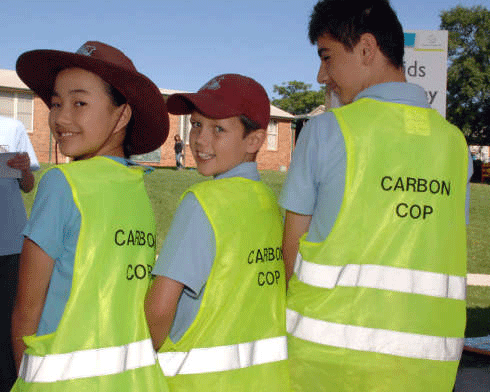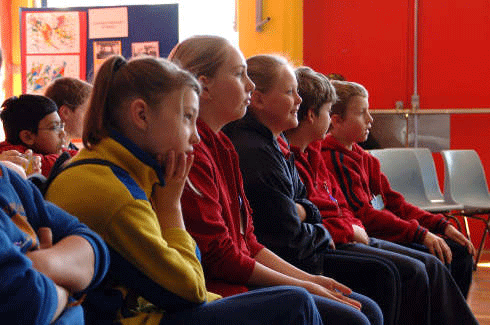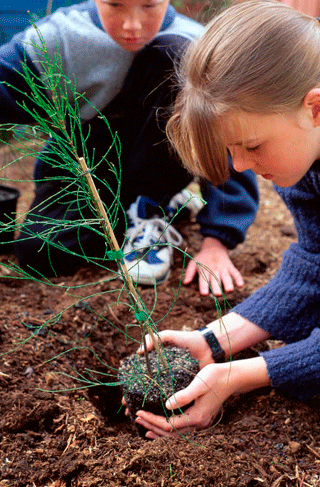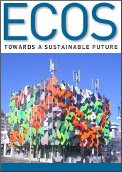
|
Published: 8 August 2011
Science a good start to understanding climate change
Young Australians at primary and lower secondary school levels are learning about the underlying science of climate change and taking a positive approach to the issue, thanks to a schools program developed by CSIRO called CarbonKids.

|
|
Students at one school came up with a ‘Carbon Cops’ program under which they take turns to check that lights and computers are switched off when required. Credit: CSIRO
|
The program encourages teachers and students to identify relevant activities in their classrooms, schools or homes that will help reduce greenhouse gas emissions. These include saving energy and water, or recycling food waste as compost in organic gardens to help reduce methane emissions from landfill.
At the same time, CarbonKids provides a broader learning framework that challenges students to understand the science and think more critically about the information they come across: What is the primary source of information (eg a science journal or an internet blog)? Which information sources are likely to be more reliable than others? Is the language used emotive or objective?
Students also learn to differentiate between concepts like carbon pollution and greenhouse gas emissions, and weather and climate.
Scientists in the classroom
CSIRO scientists have been involved in contributing to and reviewing resource materials, as well as participating in classroom visits and with the CarbonKids science workshops that are facilitated in each state and territory every year.

|
|
CarbonKids provides a broader learning framework that challenges students to understand the science and think more critically about what they read in the media. Credit: CSIRO
|
‘The aim of CarbonKids is not to tell the students how to think, but to provide a guide to the information and let the kids work through it,’ says CSIRO’s CarbonKids Coordinator, Angela Colliver.
‘We encourage them to use critical thinking, make enquiries and assess the sources of stories they see in the media.’
In practice, this means that CarbonKids is connected to curriculum areas such as philosophy, ethics, communication and social justice.
A successful pilot program was supported by Shell Australia and, now with the funding support of Bayer, CarbonKids has expanded to more than 100 schools in Queensland, South Australia, Western Australia, Tasmania and NSW. It will soon be taken up by schools in the Northern Territory and Victoria.
At Bunbury Primary School in Western Australia – one of 26 schools that participated in the pilot – students came up with six ideas for reducing the school’s carbon footprint.
These included plastics and milk carton recycling; walking school buses; and switching off lights and computers during ‘down’ times. In mathematics classes, students measured electricity consumption, weighed rubbish, and surveyed car use.
‘There is no one formula from CarbonKids – every school engages with it differently,’ says Ms Colliver. ‘And each class in the school typically will develop a plan for reducing its carbon footprint depending on what it decides is relevant and feasible.
‘For example, initially Australind Senior High School [also in Bunbury] was engaged through its science and philosophy disciplines.
‘But then, years 8, 9 and 10 wanted to regenerate a degraded area of the school grounds. They've now got a wonderful school organic garden, they're recycling compost, they've got chooks.
‘Everything they grow is used in their Home Economics Centre and the garden's really become a hub of activity. The students designed every aspect of it.’

|
|
The many CarbonKids’ schools that plant trees and gardens as part of their carbon-reduction effort are able to use a Carbon Calculator developed with the help of a CSIRO scientist. Credit: CSIRO
|
In contrast, at Rydalmere East Public School, a small school in inner Sydney with a bituminised playground, the main priority has been reducing electricity consumption.
With the help of teachers, students came up with a ‘Carbon Cops’ program under which students take turns to check lights and computers are switched off when required.
At Scotch Oakburn College, in Launceston, Tasmania, students are measuring how much carbon is being sequestered by wetland plants within the school grounds.
‘They've chosen to do something really tough, which is how to measure how much carbon is being absorbed using the carbon calculator that Dr Roger Gifford from CSIRO helped develop,’ adds Ms Colliver.
On 30 July – National Tree Day – each CarbonKids school was set a challenge to calculate how much carbon was sequestered in trees in their school-grounds. Students will post data to a protected CarbonKids wiki space, giving CSIRO and schools a snapshot of how much carbon has been sequestered already through the program.
Perhaps one of the greatest achievements of the CarbonKids project has been its success in engaging primary school students and teachers with science.
‘This has been an incredibly successful program for us,’ said one teacher. ‘It is the first science-based program where I've seen teachers go from being tentative and superficial about teaching science, to being able to have the confidence to look at deep knowledge and deep understandings...of how and why carbon emissions will affect our future.’
More information
CarbonKids, http://www.csiro.au/carbonkids



